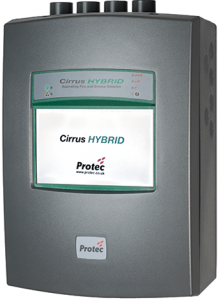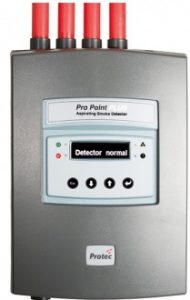Cirrus HYBRID & ProPoint PLUS
The very best in smoke and fire detection technology is put into action with the Cirrus HYBRID & ProPoint PLUS. Both products are developed by industry leader Protec, which is based in the UK and has over 40 years of experience in the field.
Cirrus HYBRID
- Combined Cloud Chamber ‘Fire’ and optical ‘Smoke’ detection
 There are two types of aspirating detector technology. The first of these is the Cloud Chamber which works by identifying fire particulate which is invisible to the naked eye. The second is laser or LED Optical detection which identifies small amounts of visible smoke.
There are two types of aspirating detector technology. The first of these is the Cloud Chamber which works by identifying fire particulate which is invisible to the naked eye. The second is laser or LED Optical detection which identifies small amounts of visible smoke.
The award-winning Cirrus HYBRID by Protec Fire Detection is the only aspirating detector available on the market today that can detect invisible fire particulate through Cloud Chamber Detection (CCD) technology.
Air is drawn in through a network of supervised sampling pipes to a wall mounted fire/smoke detector which contains an inbuilt blower to transport the air through the pipes from the space.
Aspirating technology is not a new concept, however, aspirating detectors are now being installed in an ever-increasing number of different applications. It is essential that the detector is capable of detection across the widest spectrum of fire scenarios.
By utilising the two best forms of aspirating system technologies Cloud Chamber Detection (CCD) and Early Warning Smoke Detection (EWSD) in one detector, the Cirrus HYBRID detector provides a device able to detect fire and smoke over the largest range of fire types. Some fires can produce very little or even no smoke. Cloud chamber detectors (CCD) have proven to be the earliest fire detection technology, as they can identify optically invisible combustion particles created as a material overheats and more importantly before smoke is produced (i.e. 0% obs/m).
An important result of this synergy of technologies is the elimination of false alarms which continue to plague so many optical only aspirating detectors.
Aspirating detection has become the accepted solution for many applications including general and high bay warehousing, cold storage, atriums, ceiling voids, high ceiling spaces such as airport lounges, indoor arenas, and theatres. Power and other utility plants, industrial conveyor systems, very dusty areas and many more harsh environment applications are now protected by aspirating detection systems.
ProPoint PLUS
- A reliable detector system ideal for harsh environments
 The ProPoint PLUS aspirating detector is ideal for smoke detection in harsh environments. ProPoint PLUS can be used in situations where it can be difficult to maintain a fire alarm system.
The ProPoint PLUS aspirating detector is ideal for smoke detection in harsh environments. ProPoint PLUS can be used in situations where it can be difficult to maintain a fire alarm system.
ProPoint PLUS is fitted with an optical smoke sensor which is able to react to fires faster than a standard optical smoke detector is able to. ProPoint PLUS has the option to be equipped with a CO sensor, making it even more reliable. It works by detecting the CO concentration increases during the first phase of the development of a fire. Even before visible smoke particles are visible the CO-sensor detects the increase of CO in the air samples.
ProPoint PLUS provides up to four separate detectors within a common aspirator enclosure which means that it has four individually identifiable areas of detection per aspirator. ProPoint PLUS also utilises LED “optics” for verification of smoke levels.
Complex algorithms extend the range of particle detection, confirm genuine alarms and reduce unwanted alarms. It is simple to install, configure and operate Pro Point Plus detectors.
Configuration to either Class A, Class B or Class C sensitivity options is achieved through a multi-language, multi-function LCD display without the need for a laptop connection. The installer can configure the detector sensitivity to exactly the same equivalent as a known number of point type smoke detectors for each Class A, Class B and Class C system.
Aspirator fan speed and airflow configuration is also a very simple process allowing ProPointPlus aspirating detectors to be installed in a variety of situations with short and relatively long pipe runs.

